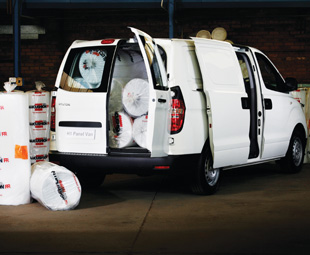Handy Hyundai

A relatively new challenger in the one-ton panel van segment of the market emerged earlier this year, the Hyundai H1 2,5 CRDi Panel Van. GAVIN MYERS gives you his thoughts.
If you’re looking for an honest, back-to-basics, workaholic of a panel van, Hyundai has come up with one to give rivals something to think about. The H1 range has been on our shores for a few years now, but only in February this year did Hyundai decide to drop its 2,5 CRDi common-rail diesel engine into the panel van – the vehicle was previously available only with the petrol 2,4 MPI.
This all-aluminium engine is one of the most powerful available in a panel van, producing 120 kW at 3 800 r/min and 392 Nm at 2 000 r/min, and will quite happily run on a diet of 500 ppm. These figures stand up well compared to the 2,4 MPI’s 126 kW and 224 Nm, and the extra torque makes life for the big vehicle (especially when carrying a load) much easier. It is an impressive engine – fairly quiet once warm, smooth and free-revving, with lots of pull throughout the rev range.
 The H1 is rear-wheel driven, resulting in good traction when there is weight in the back. When there isn’t, the torque can cause the inside rear wheel to spin if you turn a bend with too much throttle and the turbo begins to boost. The H1 Panel Van does not come with a traction or stability control system; however anti-locking brakes (ABS) and electronic brake-force distribution (EBD) are fitted as standard.
The H1 is rear-wheel driven, resulting in good traction when there is weight in the back. When there isn’t, the torque can cause the inside rear wheel to spin if you turn a bend with too much throttle and the turbo begins to boost. The H1 Panel Van does not come with a traction or stability control system; however anti-locking brakes (ABS) and electronic brake-force distribution (EBD) are fitted as standard.
The all-disc brakes are powerful enough to bring the laden vehicle to an easy stop, but feel dead in their operation, which can be a little disconcerting. The gearbox also failed to impress, but it should stand up to the use expected of it nevertheless.
Standard safety features include dual airbags and seatbelt pre-tensioners, with a lap-belt for the middle occupant. More than enough space is provided for three adults to travel comfortably – the interior feels airy and spacious, and the seats themselves are also very comfortable. When there is no third crew member, the middle ‘seat back’ can be folded down flat to provide two additional cupholders and an (unfortunately uncovered) oddments tray. Other storage compartments include two small cubbyholes, two sizeable pockets in each door with space for a fair-sized flask, and trays under the radio slot and on top of the dashboard – more than enough for the average driver and crew that would do the rounds in such a vehicle, not forgetting the space directly behind the seats. The cabin is sealed off from the cargo area.
The vehicle itself imparts a well-built feel, with the exception of a rather annoying high-pitched squeak emanating from the cargo area throughout our time with the H1. The quality of interior fit and finish is something of a mixed-bag in the panel van; the solid, soft-touch dashboard and durable-feeling seat coverings impress, but the centre consol looks likely to suffer over the years and some of the driver controls feel flimsy. But it is otherwise a pleasant environment for the crew.
On to the important stuff: the H1 Panel Van boasts 4 308 dm3 of cargo space, with the illuminated cargo area having a load length of 2 375 mm, width between the wheelarches of 1 250 mm and a load height of 1 350 mm. There are ten lashing points to secure the maximum load of 1 100 kg (the H1 CRDi can also tow up to 1 500 kg). The load sill is low, at 550 mm, so whoever is doing the loading shouldn’t sweat too badly or give themselves a hernia… Loading is further eased by light sliding doors (that lock themselves in place when open) on both sides, as well as double rear doors that can open up to 180°.
 A point of contention, though, is that the rear doors are split directly down the middle, which compromises rearward visibility, especially when using the rear-view mirror. But that’s nitpicking, considering they’re not blanked out completely. Of course, overall visibility is compromised somewhat by virtue of massive blind spots characteristic of a panel van. The large side mirrors aid reversing and parking, though seeing the wagon’s electronic park distance control on the options list would no doubt be welcome to avoid the inevitable ding that will happen if multiple drivers share duties. An experienced driver shouldn’t have too much difficulty, though. On the point of mirrors, something rather perplexing was that, so far as I could see, there is no way to adjust the Panel Van’s side mirrors other that to physically manoeuvre them from outside the vehicle…
A point of contention, though, is that the rear doors are split directly down the middle, which compromises rearward visibility, especially when using the rear-view mirror. But that’s nitpicking, considering they’re not blanked out completely. Of course, overall visibility is compromised somewhat by virtue of massive blind spots characteristic of a panel van. The large side mirrors aid reversing and parking, though seeing the wagon’s electronic park distance control on the options list would no doubt be welcome to avoid the inevitable ding that will happen if multiple drivers share duties. An experienced driver shouldn’t have too much difficulty, though. On the point of mirrors, something rather perplexing was that, so far as I could see, there is no way to adjust the Panel Van’s side mirrors other that to physically manoeuvre them from outside the vehicle…
Options that are available include air-conditioning (fitted to our H1 at R10 000), alarm/immobiliser and a sound system (for which the vehicle is pre-wired). Full central locking is fitted (key operated), which automatically locks at 20 km/h.
For many fleets buyers, the Hyundai H1’s trump card is likely to be the five-year/150 000 km warranty and roadside assistance plan, as well as the five-year/
90 000 km service plan (service intervals are 15 000 km). These are both included in the base purchase price of R274 900, which makes this an appealing prospect especially when weighed-up directly against the competition.
Published by
Focus on Transport
focusmagsa



